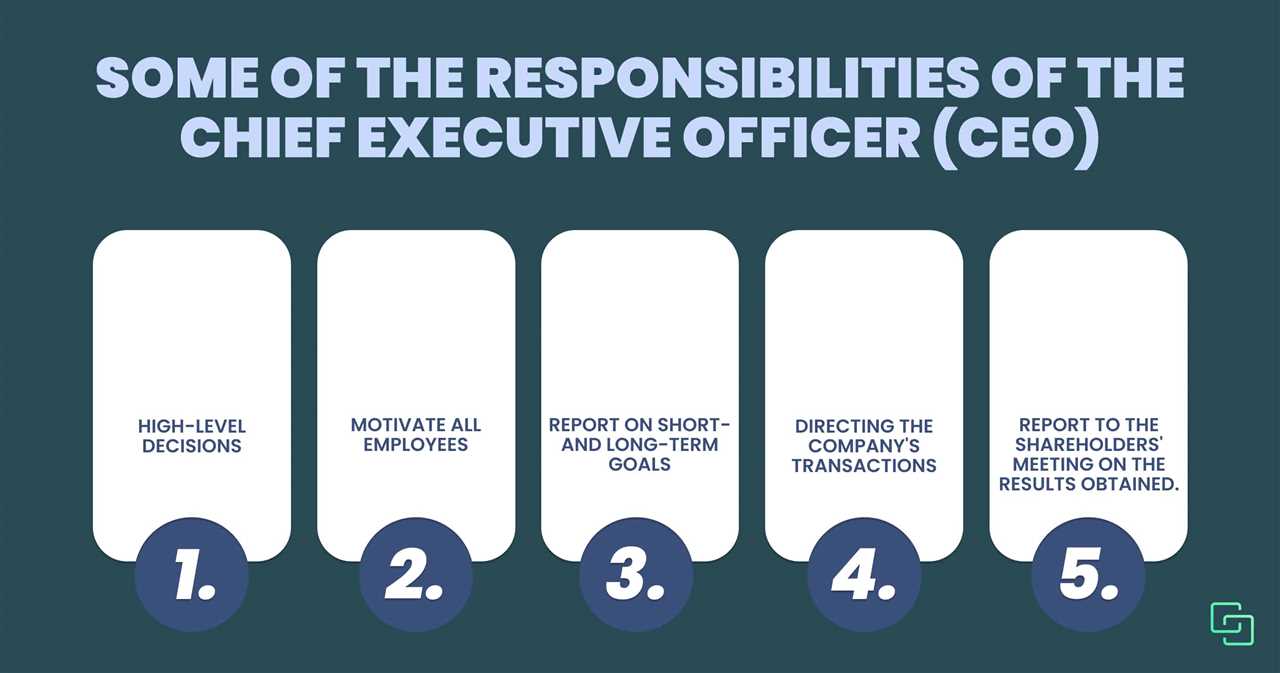Chief Executive Officer (CEO) vs Other Chief Roles: A Comparison of Responsibilities

While the CEO is often considered the highest-ranking executive, there are other chief roles that play significant roles in the overall management and success of a company. These roles include the Chief Financial Officer (CFO), Chief Operating Officer (COO), and Chief Marketing Officer (CMO), among others.
The CFO, on the other hand, is primarily responsible for managing the company’s finances, including financial planning, budgeting, and reporting. The COO focuses on the day-to-day operations of the company, ensuring that business processes are efficient and effective. The CMO is responsible for developing and implementing marketing strategies to promote the company’s products or services.
While these chief roles may have different areas of focus, they often work together closely to ensure the success of the company. The CEO, in particular, plays a crucial role in coordinating and aligning the efforts of these different departments and functions.
CEO Responsibilities

Some of the key responsibilities of a CEO include:
1. Strategic Planning: The CEO is responsible for developing and implementing the company’s long-term strategic plans. This involves analyzing market trends, identifying growth opportunities, and making critical decisions to drive the company’s success.
3. Decision Making: The CEO is responsible for making important decisions that impact the company’s operations, finances, and overall performance. They must consider various factors, such as market conditions, financial data, and input from key stakeholders, to make informed decisions.
4. Financial Management: The CEO oversees the financial health of the company and ensures its profitability. They work closely with the CFO (Chief Financial Officer) to develop and manage the company’s budget, monitor financial performance, and make strategic investments.
5. Stakeholder Management: The CEO represents the company to its stakeholders, including shareholders, customers, employees, and the public. They build and maintain relationships with key stakeholders, address their concerns, and ensure the company’s reputation is protected.
6. Talent Development: The CEO is responsible for attracting and retaining top talent in the organization. They work with the HR (Human Resources) department to develop talent acquisition strategies, foster a positive work culture, and provide opportunities for employee growth and development.
7. Risk Management: The CEO identifies and manages potential risks that could impact the company’s operations or reputation. They develop risk management strategies, implement appropriate controls, and ensure compliance with relevant laws and regulations.
In summary, the CEO has a multifaceted role that requires strong leadership, strategic thinking, and the ability to make critical decisions. They are responsible for driving the company’s success, managing its resources, and ensuring its long-term sustainability.
Comparison with Other Chief Roles

While the Chief Executive Officer (CEO) holds the highest position in a company, there are other chief roles that play crucial roles in the organization’s success. Let’s take a closer look at how the CEO compares to these other chief roles:
Chief Financial Officer (CFO)
The CFO is responsible for managing the financial aspects of the company. They oversee financial planning, budgeting, and reporting. Unlike the CEO, who focuses on the overall strategic direction of the company, the CFO’s primary focus is on financial operations and ensuring the company’s financial stability.
Chief Operating Officer (COO)
The COO is responsible for overseeing the day-to-day operations of the company. They work closely with the CEO to implement the company’s strategic plans and ensure that operations run smoothly. While the CEO focuses on the big picture, the COO focuses on the operational details and execution.
Chief Technology Officer (CTO)

The CTO is responsible for the company’s technological strategy and innovation. They oversee the development and implementation of technology solutions that align with the company’s goals. While the CEO sets the overall vision, the CTO ensures that the company stays up to date with the latest technological advancements.
While each chief role has its specific responsibilities, the CEO plays a unique role in setting the overall direction and vision for the company. The CEO works closely with these other chief roles to ensure that the company’s goals are met and that all departments work together effectively.

Emily Bibb simplifies finance through bestselling books and articles, bridging complex concepts for everyday understanding. Engaging audiences via social media, she shares insights for financial success. Active in seminars and philanthropy, Bibb aims to create a more financially informed society, driven by her passion for empowering others.
